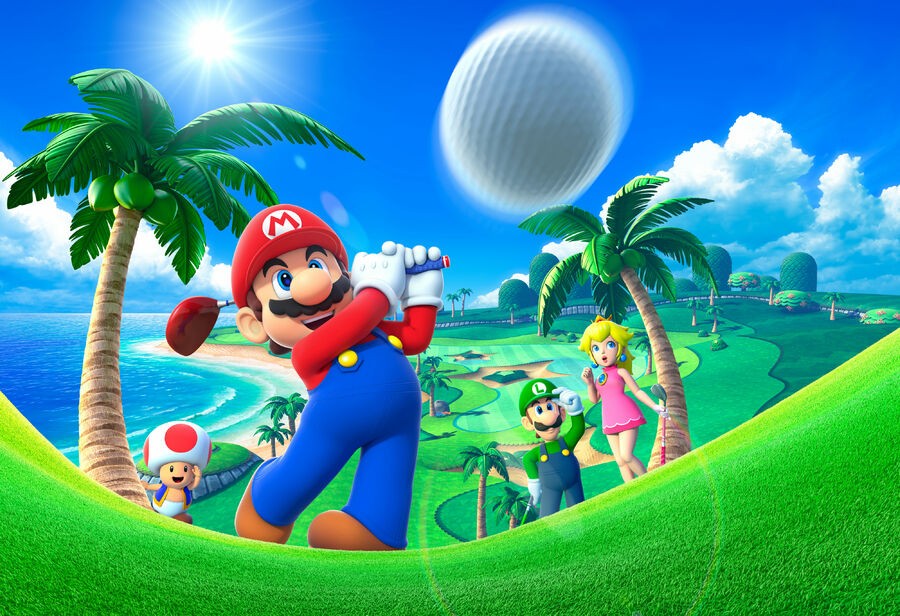
Mario Golf: World Tour has had an odd history to date. Announced in early 2013 for a "Summer" release, it was quietly pushed back to later in the year before drifting into 2014 with little attention going its way; perhaps distracted by the sheer range of hot releases on 3DS throughout the year and the ongoing issues and talking points around Wii U, very few beyond the most eagle-eyed and attentive have been asking just exactly what's been happening with Camelot's latest release. Even its announcement for a 2nd May release passed without much fanfare, with attention diverted by other May arrivals such as Kirby: Triple Deluxe on 3DS and the Wii U's most important title to date, Mario Kart 8.
If you haven't been paying attention to Mario Golf: World Tour, then that's something to change right now.
Camelot made its 3DS début with Mario Tennis Open in May 2012, a solid but unspectacular effort that was rather safe in its approach. Its core feature was online play, and there was some rather minor upgrade potential through outfits and equipment that was reliant on playing a great deal of matches and tournaments in various modes to earn coins. While the same core coin economy passes across to this new entry, our early impressions suggest that the comparisons end there.
With a history in previous golf and tennis titles with an emphasis on RPG elements and being more than simple albeit extravagant sport games, Camelot's first effort on 3DS perhaps disappointed with a focus almost exclusively on the tennis matches and not an all-encompassing career mode. While it's too early to say whether Mario Golf: World Tour has a fully immersive RPG-lite experience to suck us in for months on end, we can say that the potential is undoubtedly in place.
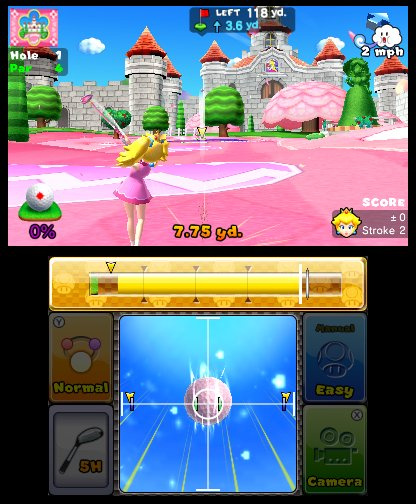
In terms of the core play itself, it's immediately apparent that Camelot is keen to support both new and inexperienced players alongside more skilful gamers, without necessarily compromising the experience for either side. For those in the former category, stepping onto the course only requires simple shot selection and timing — utilising Auto mode, the only real responsibility is selecting a direction and using A (or the touch screen) to initiate and time a shot. Switching to Manual mode — which can be done at any point, even between shots — is arguably the best way to play, however; it provides impressive depth and challenge to each stroke.
As opposed to Auto's focus on power alone, with accuracy taken care of, the initial swing in Manual mode brings in the rather standard three-button-press to initiate the swing, set power and then determine the accuracy. Hitting the exact marks in both power and precision is tricky, naturally, but rather like the button combo swings of Mario Tennis Open you can also use simple combinations to apply additional effects. As the shot gauge moves on its final route you can apply the final press with the A or B button, setting up four potential combos; you tap again quickly after the shot is initiated to add topspin, super topspin, backspin or super backspin. On top of that there are multiple shot types and club selections to consider, while you can also deliberately manipulate your shot to fade or draw. It takes a little time to wrap your head around the possible options, but it starts to become natural.
In terms of game modes, it says much for the depth of the offering from Camelot that we're still simply scratching the surface, while there are elements that we cannot cover as yet. It's a world away from the sense of seeing much within a few hours of firing up Mario Tennis Open, with two core areas that support jump in and play moments and longer sessions when you want to indulge in the full "career" aspect.
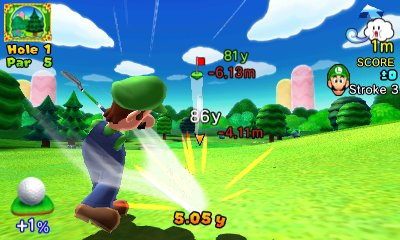
To begin with Quick Round: Mario Golf, it's a series of modes where you can play as various Mushroom Kingdom characters or your customised Mii. Single player offers up standard stroke play, Match Play where you take on a computer opponent, Speed Golf in which you attempt to rattle through holes as quickly as possible, and Point Play that converts your scores from strokes into points. All contribute coins to your total when completed and can be a lot of fun — rattling around 18 holes in 25 minutes is both possible and surprisingly intense. Most pleasing is that there's plenty of customisation in every mode: you can choose the number of holes from 3, 6, 9 to 18, while adding quirky Mario-style ideas such as a slot machine that limits available clubs and items. Items in particular can be entertaining, activated as a "special" shot type with various effects — bob-ombs prompt your ball to explode high into the air, a fire flower will allow your ball to burn through trees, a boomerang can add unlikely swerve and many more. Add to that tricky challenge holes that task you with collecting Star Coins while also making par, and there's a lot to take on.
These activities all help you to accumulate currency, and it's in the Play as a Mii: Castle Club that this wealth is not only accumulated further, but becomes more relevant. As with Camelot's previous 3DS release, you can use your coins to purchase clothes, accessories and additional clubs that not only enhance your primary statistics of Sweet Spot and Control — worth boosting to make basic stroke play that little bit easier — but also allow you to increase drive distance and the play style of your Mii. Eight categories of outfits and accessories look likely to take a long time and plenty of completed courses to populate, and look set to add impressive customisation options.
Beyond buying items, however, the Castle Club is the area that will dominate most play time. It's a sizeable, colourful place in which you run around with your Mii, and to a degree has a slight vibe of Animal Crossing: New Leaf — from the quirky running animation of your avatar to the characters standing around happy to exchange a few words, it creates a peculiar but delightful environment to explore. Aside from some minor tips from obliging characters, you're left to explore rooms, trying different doors and staircases to stumble across areas with no aim other than to provide some charming context, and others that house tournaments and challenges.
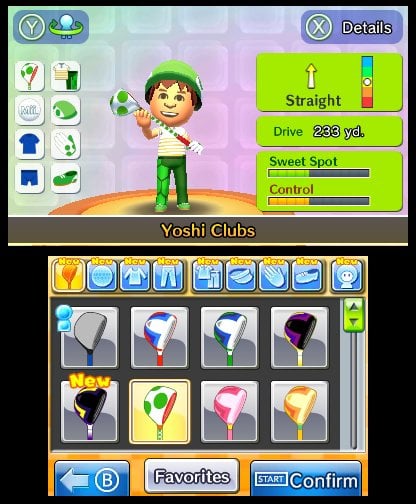
Beginning in a building, you eventually venture outside to where much of the action is to be found. Our time-to-date has taken us through early stages, beginning with a "practice round" on one of three initial courses to set a handicap — from that point you can enter tournaments and gradually progress to Championship rounds. A typical 18-hole round takes us between 30-45 minutes, and consistently developing skills, tweaking clothes and items and learning courses takes away any sense of repetition. Beyond rounds on courses there are also extremely useful challenges that cover drives, approach shots and putting at multiple difficulty levels, useful for accumulating coins and perfecting technique. We feel like we've barely started to see what's on offer, only catching hints and question mark teases of an expansive and substantial set of unlockable treats and courses.
What's also impressive and worth early recognition are the visuals and performance. While character models and environments are chunky and basic on a technical level, this title is pleasing on the eye and utterly charming. Small touches such as Mii characters registered on the system gathering to celebrate your score after each hole, to large Nintendo mascots such as Bowser and Donkey Kong raggedly swinging the club with one hand, add to its ability to raise a smile. Like titles such as the aforementioned New Leaf and others such as Luigi's Mansion: Dark Moon, Nintendo and its development partners continue to take the limited resolution and capabilities of the 3DS and transform them, impressively, into assets that allow a clean, cartoon-like feel. It's full of joyful colour, with effective 3D depth and minor visual touches that do much for its appeal — seeing a golf ball on the touch screen zoom off and "into" the top screen as you swing is just one example.
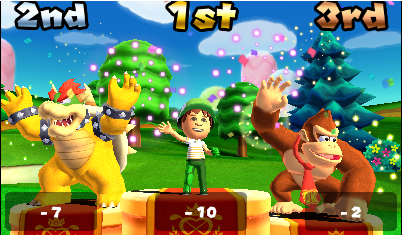
Our experience to date is entirely offline, too, so we can only look ahead to what seem to be substantial online options; online and local multiplayer sit waiting in the Quick Round mode as promised by Nintendo — local multiplayer, according to the manual, requires each player to own a copy. We're keen to try the Community option, after it was so welcome in Mario Kart 7, while the Castle Club also has a room teasing us with online tournaments. How these aspects will all come together will be of great interest.
When you consider the substantial modes on offer, the Castle Club career upon which we're only just embarking, and all of the online aspects yet to spring to life, this promises to be one of the most engrossing time-sinks on 3DS this year. Its quick-play options are fun and will suit a quick play on a morning commute, yes, but there seems to be significant depth to enjoy; we'd also like to think that given time even less confident players will take off the training wheels, switch to manual mode and truly dive in. Ignoring the slightly cautious recommended line of the game, adjusting for wind and attacking the pin with optional backspin is simply a delight when it works; actually, it's satisfying even when it doesn't work as planned. Most notably, we just want to keep playing. The 3DS triumphed in 2013 with a few key experiences that, conceivably, could devour dozens of hours and make time pass in a flash, games both accessible and complex at once.
To our surprise Mario Golf: World Tour could pick up that mantle in 2014.





Comments 51
This looks good but it makes me wonder if they'll ever actually make a Mario Golf game that uses Wii Motionplus!?!? Or a 1080' game that uses the Balance Board
As much as I like Wii Sports Club for the U, I wish they would've made it Mario Sports Club. That would've pushed some systems I think.
I won't be getting this because I'm not a golf fan, but I'm happy that the 3DS is getting another solid title added to its library.
Lets go and make a baseball game like Ken Griffey Jr baseball
I'm actually looking forward to this more than Kirby TD and Mario Kart just because it's been almost 11 years since the last Mario Golf game! Golf seems so suited to handheld gaming too. Nice and relaxing.
Can't wait!
Lost my interest immediately. No download play= no real purpose for buying (For me, at least, because I would buy it for the multiplayer, but you have to have multiple copies).
Having just finished up Mario Golf GBC after 25+ hours of fun, I look forward to this being the next big time sink on my 3DS. Sound promising based on this preview.
@arnoldrobinsonj Amen. We need a good baseball game on 3DS and WiiU!
Very disappointed in the lack of download play. My house doesnt have the money to dish out on three copies of the same game like that. Also my brother would definitely play this game on download play, but doesnt like the series enough to buy the full game and play on his own. I just dont get why they didnt include it as an option.
May 2nd is going to be a fun gaming day for me and others, this and Kirby Triple Deluxe come out on the same day.
Believe it or not this is my most anticipated game of 2014! That we know of anyways. Really looking forward to this as is seems they've done it right. I'm guessing they used the extra time wisely??!
I don't like RPG elements in anything other than RPG's (Even then only when they are done right so it doesn't involve any grinding just doing subquests if you are too low a level).
I didn't like the way the online was done with Tennis Open. (Not even a way for if the other player is not using a star character to downgrade me as well).
I wasn't much interested till I read how deep the gaming experience is. Looks like another must have for my 3ds..
I've got this one preordered and paid off and am looking forward to picking it up.
This is going to be the best golf game ever since TT. I hope they have bloopers and that hilarious intro!
@Evenmoresteven @Nintenjoe64 Exactly my thoughts in both of your comments! I think Nintendo wasteda golden opportunity on the Wii (and now on U) by not releasing Mario Tennis, Sluggers, and Golf with full (not just simple waggles) Wii Motion Plus support.
To me, doing so would be the most logical course of action.
Got mine pre-ordered. Can't wait!
This game will be legendary
Just tell me when the Nintendo Life community tee-off is. Beyond hyped for this beauty game.
Lack of download play is a bummer, but I'll still wait for reviews. Sorry to whine, but I was tremendously disappointed by Mario Tennis Open, to the point where after 20+ hours worth playing I heard a friend got a 3DS, and I gave him my copy to keep. I hope this new Golf will be good.
This looks good so far. If this wasn't after my birthday, I would put this on my wish list. Hopefully this is stronger than that tennis open one
@MagicEmperor
Golf and Tennis are two totally different games though. In tennis you are always playing against an opponent, while in golf you are just competing with yourself and trying to improve. I too got tired of Mario Tennis VERY quickly, but I'm still playing Mario Golf 64 15 years later!
Will get this in the first 2 months of release.
Now, let's get Mario Football(not soccer) next, by Camelot.
Can't wait for this one, loved the one on N64 and this reminds me of it in ways.
@arnoldrobinsonj Close. Frank Thomas baseball
Eh, this game is for casuals. Give me more real games Nintendo. I am looking forward to Kirby, hopefully that doesn't flop like Yoshi's New Island.
Also Azure Striker looks bada**.
@arnoldrobinsonj From your lips to Nintendo's ears. I was disappointed to see that the new RBI baseball game made no mention of the 3DS.
Disappointed about needing to own multiple cartridges for local multiplayer otherwise sounds like a fun game
Nice! I loved Mario Golf Advance Tour and this one is shaping up to be great as well! The fact that there is also the ability to converse with various characters in the game definitely puts this on my hopeful wish list!
All I'm hoping for is that the Miis won't be overpowered like they were in Mario Tennis Open, and hopefully have WORLDWIDE online mode, and I'll be sure to have a blast with this one.
Graphics are impressive, that's pretty rare coming from a Nintendo game. The Miis are the only repulsive thing on display there.
I'll buy if the price ever drops (likely not then). A golf game costing 30/above?... yeah no. Just ensures It will be ignored by all but fanboys.
ima need this for Wii U ASAP
@barnetbee1
Just ignore. Some people here only spout negativity, and insinuate insults toward others who disagree. Like saying unless you ignore this game, you're a fanboy. Which is utter nonsense, obviously. As if the notion of gamers enjoying golf games is unheard of or something... I've been playing golf games for decades (all of which were full price games btw)- and I don't plan on stopping any time soon.
It looks like a fantastic game doesn't it? And for only $34.99 too! Nintendo's really been knockin it out of the park with their pricing lately. They're defying traditional MSRP for many of their games- GOOD, QUALITY games at that. Kirby Triple Deluxe is also just $34.99. Fortunately for me, some online retailers here in the US have those two games listed for just $29.99, and of course I took advantage to pre order right away.
Can't wait for this game. I hope it's as good as Mario Golf on GBC.
@barnetbee1 It's just golf, we all know what to expect from the generic Nintendo sports entry, i.e. not much, content wise. I wouldn't even consider buying if i didn't like golf games. Still won't be worth more than £15-20, to me.
If it wasn't for Mario Kart 8 coming out, which I'm buying a Wii U to play, I'd be getting this. The 3DS seems like a natural fit for a Mario Golf game.
Very excited for this game!
Is it okay to admit that golf is my favorite Mario spin-off?
@arnoldrobinsonj
Good idea! that is still the best baseball game ever!
I apologize for being completely out of topic, I can't find any information on this. To people who have Petit Computer, if you decide to share your game with a QR code, can you choose whether others can edit your game or not? And do you get credit for the game you made?
@Thats-what-she Yep. The Golf games are my favorite Mario spin off series too.
@Dark-Link73 I just don't understand why they never made games like that for wii or wii u? total fail
So, Thomas... RPG-like features or no? I noticed you started to mention their possibility and then kind of trailed off.
Anyhow... Look at you go May! Mario Golf and Kirby: Triple Deluxe for 3DS (on the same day no less!) and Mario Kart 8 at the end of the month. Thank you Nintendo!
@JohnRedcorn Oh, I know, but thanks. Sorry, I should have clarified that Tennis Open disappointed me as a Mario Tennis game, not a game of tennis. My bad. And nice avatar. lol
@Doma "Graphics are impressive, that's pretty rare coming from a Nintendo game." - You're sure about that?
@XFsWorld Very sure. Just look at Pokemon (overworld), Zelda ALBW, New Yoshi Island, Mario & Luigi, NSMB2 etc.. with their ugly low-budget visuals. Rarely do we ever see anything actually impressive from them.
@Doma ok then look at Kid Icarus: Uprising, Luigi's Mansion Dark Moon, Pilotwings Resort, Mario Kart 7, and Mario Tennis Open.
I'll buy it if it has Rosalina... or Elsa.
Mario Golf 64 was and is a staple game for me.... Getting an updated MOBILE version is AMAZING!! For me....... 1st day buy (or find a place with e GREAT pre-order!)
Can't wait....
@Diddy_kong Mario Golf on the Nintendo 64 was the reason that I liked golf to begin with, so I highly recommend that you check this out, anyway.
Leave A Comment
Hold on there, you need to login to post a comment...